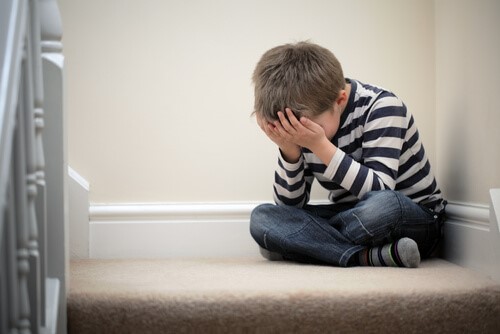How To Fight Childhood Anxiety

Childhood anxiety is a lot more common than you might think, and there are many causes. That’s why it’s important to prevent and diagnose it in time.
Most people believe that children are always happy and “they have nothing to worry about,” yet this isn’t true.
Statistics show that up to 20% of children suffer from some type of childhood anxiety.
What causes childhood anxiety?
There are distinct types of anxiety which arise from different causes. Having basic knowledge of anxiety can be useful.
Caretakers should provide children with all of the essential tools to help them channel their emotions in a healthy way.
The causes of anxiety depend on the child’s age. Here are a few common causes of childhood anxiety:
- Physical or psychological abuse.
- Conflict between parents.
- Sudden abandonment of a parent.
- Traumatic events of any kind.
- Financial hardships.
- Excessive responsibilities.
- Sudden changes in the child’s daily life such as changing houses, the birth of a new sibling or the death of close relatives or loved ones.
- Lack of routines and order. This includes constant changes in their sleep or feeding patterns.

- Lack of contact with one or both parents.
- Uncomfortable situations at school.
- Absence of clearly identifiable limits.
- Lack of physical activity.
- Excessive consumption of sugar.
- Exhaustion or fatigue due to multiple activities during the day.
- Lack of confidence or self-esteem.
- Anxiety about parents separating.
Parents or caretakers are responsible for identifying the cause of a child’s anxiety. They are also responsible for finding a solution.
Measures that can be taken to fight childhood anxiety
1. Avoid guilt
It’s common for parents to feel anxious if their children are suffering from anxiety. It may sound ironic, but this does happen. Some parents even begin to feel guilty after noticing their child suffers from anxiety.
Guilt doesn’t help and that’s why it’s best to avoid it. Acting while feeling guilty can lead parents to make bad decisions. It’s important to differentiate between responsibility and guilt in order to start taking the necessary measures.
2. Talk
It may seem obvious, however not all parents do it. It’s important to let the child vent. Listen attentively to what they say in order to understand their feelings.
Don’t force the child to speak, this can create the opposite effect. You don’t need to give sermons or long dialogues on what should be done in order to encourage dialogue.
Parents simply need to establish a bond which will allow their children to feel free to express themselves.
“The people who care for a child should provide them with all of the essential tools to help them channel their emotions in a healthy way.”
3. Be a good example
Children learn to deal with their emotions and face their problems the way their parents do. That’s why we should act as role models: we should deal with stressful situations the way we would like to see our children do so.
4. Diet
Consuming sugar excessively can alter a child’s behavior. Children have a lot of energy naturally. If they’re given more sugar than their body can process, they’ll lose control.
In addition, the child might not have space to burn all of their excess energy.

5. Don’t be too demanding
Parents should know that their children aren’t perfect. It’s important to let them know that you love them despite the mistakes they make.
Being too demanding can generate a lot of stress for a child. A typical example of where parents can be too demanding is with a child’s grades.
This can also be the case with sports. Children who feel like they have to be perfect or the best are more inclined to suffer from anxiety.
6. Love
How can we give our children the tools necessary to face stressful situations? In order for a person to face stressful situations they must first feel capable. This is closely related to self-esteem.
In order for a child to have confidence in themselves, they must feel their parents’ unconditional love. Parents shouldn’t show affection only in the celebration of achievements.
We must be affectionate at all times and spend time together in order to make them know that we value them.
All cited sources were thoroughly reviewed by our team to ensure their quality, reliability, currency, and validity. The bibliography of this article was considered reliable and of academic or scientific accuracy.
- Bragado, C., Bersabé, R., & Carrasco, I. (1999). Factores de riesgo para los trastornos conductuales, de ansiedad, depresivos y de eliminación en niños y adolescentes. Psicothema, 11(4). https://www.redalyc.org/html/727/72711415/
- Cárdenas, E. M., Feria, M., Palacios, L., & de la Peña, F. (2010). Guía clínica para los trastornos de ansiedad en niños y adolescentes. México: Instituto Nacional de Psiquiatria Ramón de la Fuente Muñiz.
- Fernandez, L. E. (2009). Ansiedad infantil e implicación de los padres: una revisión. Behavioral Psychology/Psicologia Conductual, 17(1), 67-88. https://go.galegroup.com/ps/anonymous?id=GALE%7CA226571530&sid=googleScholar&v=2.1&it=r&linkaccess=abs&issn=11329483&p=AONE&sw=w
- Reynolds, C. R., & Richmond, B. O. (1997). Escala de ansiedad manifiesta en niños (revisada). El Manual Moderno.
This text is provided for informational purposes only and does not replace consultation with a professional. If in doubt, consult your specialist.








